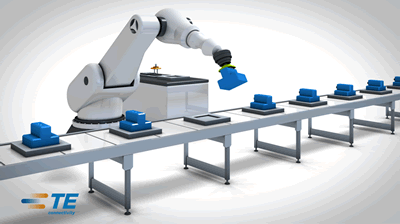Problem Solved: Opening Up Possibilities for the Robotics Industry

Early on, the product development teams at TE Connectivity realized that in order to create groundbreaking solutions and invent superior products, it was imperative to understand the application in context, including all the business requirements. That’s why TE expanded its team of field engineers to support customers at their sites. These engineers regularly engage with customers to fully understand their needs and their obstacles, then participate in a collaborative dialogue as a catalyst for innovation. This relationship made it clear that existing connector solutions couldn’t fulfill every customer need.
The field of robotics, for example, has evolved dramatically, from the rudimentary industrial robots first introduced in the 1960s, to the ultra-sophisticated intelligent robots of today. Whether for hazardous environments too dangerous for humans, like radioactive cleanup or bomb disarmament, or routine industrial settings, including automobile manufacturing or the food and beverage industry, robots can perform a wide range of tasks in diverse situations. Despite rapid advancements, mechanical limitations remained the primary challenge for the robotics industry.
Mechanical construction has its limits. Robots are a good example of mechanically constructed objects that use motors to generate movement. These motors power the cables that run either beside a robotic arm or are fed through it. There are several downsides to the mechanical aspects of this construction. Not only do the cables limit range of motion, but the constant movement and friction of the mechanical parts also create wear and tear. This leads to frequent breakage and connector failure, as well as downtime, when operators must replace the worn cables with new ones.
In addition to linear movement, robots also need to move rotationally to perform complex tasks. Traditionally, rotation is achieved with rotating connectors, or slip rings, which are mechanically connected to stationary rings via brushes. Cables are used to position these copper rings in close proximity to enable physical contact with the carbon brushes. Carbon then transfers the electrical current to the ring, thus creating rotation. This constant friction creates wear and tear on the brushes, which must be replaced frequently, resulting in downtime that reduces productivity.
While investigating alternative technologies, TE engineers realized that developing a contactless or wireless solution seemed like a natural path to go down, provided the solution would be as reliable as standard wired power and signal, but with wireless flexibility. They wanted to find a very reliable and affordable solution that would also be small enough to allow easy integration into customer applications, so they studied and compared the attributes of various technologies that could transmit power and signal. The evaluation criteria included size, cost, efficiency, and the ability to transmit over a certain distance. Additionally, how would the technology stand up in harsh and safety critical environments? Could it transmit through water? Would it minimize or eliminate arcing? Should it penetrate metal? Would background noise interfere with transmission?
Inductive coupled power transfer emerged as the most viable technology, since inductively coupled devices can transfer power and data across small distances without any contact. The stationary pieces, such as a robot arm, could transfer power inductively to a rotating, indexing, or fixed mobile part, like a gripper. The mobile part makes the power available to power sensors, heaters, cameras, valves, motors, microprocessors, or batteries while it also feeds the data back to the stationary piece. Another advantage of inductively coupled devices is their ability to operate reliably in very demanding environments — underwater, in vacuum chambers, ultra clean environments, surrounded by grease or mud, or on equipment that is spinning at high rpm. Because there are no moving parts to wear out, these devices are virtually maintenance-free, making this a very attractive technology for our client base.
Once TE engineers identified the technology, the objective was to integrate the power coils and near field antennae into a very small form factor and then manufacture it. TE Connectivity has expertise with both mechanical design and power electronics, as well as magnetics, RF, and antennae. These unique competencies led the team to solve the potential problem of electromagnetic interference by using RF chips coupled with near field antennae, and they were able to reduce the total cost of the couplers by building a streamlined solution using fewer components, while improving performance and reliability.
TE’s ARISO CONTACTLESS CONNECTIVITY platform allows customers to implement devices in applications where standard connectors and cables could not be used before, and it will enable an entirely new way of thinking about mechanically designed machines. One may envision, for example, a totally new, more sensitive robot that has complete freedom of movement. The platform provides the building blocks that allow customers to imagine new products and to create them.
The ARISO CONTACTLESS CONNECTIVITY platform transforms the world of robotics in many ways. Without friction as the by-product of mechanically constructed parts, the deterioration of moving components is no longer a limiting factor. Not only does this increase machine availability, it also decreases the cost to operate those machines, with less moving parts to replace, and lower maintenance fees.
Also, the technology provides design engineers with 360° of flexibility. When a mechanically constructed robotic hand rotates to its fullest extent, it reaches 270°. When returning to the point of origination, it is faster and more efficient to rotate the additional 90° forward. However, due to the mechanical limitations of the cable, it must go back 270°. This process increases production time by a factor of three. Using contactless couplers enables manufacturers to triple their throughput, generating three times more product within the same time period.
On the other hand, not every process requires increased productivity; sometimes you need greater precision. When picking and packing certain products or handling sensitive materials, for example, a minimal amount of force is required so items are not damaged. The intelligence required to perform at such precise specifications is inherent in a contactless coupler. With ARISO CONTACTLESS CONNECTIVITY couplers, the gripper or robotic hand can be equipped with electronic, or contactless, sensors that limit the force exerted and stop automatically before exceeding those levels. In addition to data transmission, contactless sensors offer additional improvements over pneumatic sensors. Pneumatic grippers are less energy-efficient, not as sensitive, and require air pressure that is not always available in certain applications. Most impressively, contactless couplers enable greater flexibility, allowing various grippers or end detectors to be used with the same robot. And since the process is automated, there is no need for an operator to physically change the gripper.
The technology provides a light touch, but is rugged enough for factory floors as well. ARISO CONTACTLESS CONNECTIVITY performs in the harshest environments, such as the oil and gas industry, which is among the most challenging environments. Robotic friction can cause even the smallest arc, which could generate a very costly, or deadly, explosion. While not life-threatening, using mechanical couplers in harsh environments, such as underwater or within lubricants or coolants, is extremely challenging due to corrosion. Rather than using contact in these conditions, hermetically sealed and galvanically isolated contactless couplers use magnetic fields to achieve connectivity.
With so many limitations removed, we have only just begun to see what may be possible. Certainly, robots in the near future will be constructed differently and, most likely, less expensively. Set up and design will be easier and simpler, and at the very least, robots will have greater freedom of movement, productivity will improve, and total cost of ownership will decrease.
Learn more about TE and ARISO CONTACTLESS CONNECTIVITY online.


